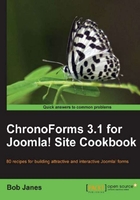
Joomla! is a fantastic way to create a dynamic CMS. Now, you want to go to the next step and interact with your users. Forms are the way you ask questions and get replies. ChronoForms is the extension that lets you do that and this book tells you how.
From building your first form to creating rich, form-based applications, we will cover the features that ChronoForms offers you in a clear hands-on way. Drawing on three years' daily experience of using ChronoForms and supporting users, there is valuable help for new users and experienced developers alike.
We will take you through form development step-by-step from creating your first form using ChronoForms' built-in drag-and-drop tool, validating user input, emailing the results, saving data in the database, showing the form in your Joomla! site, and much more. Each chapter addresses a topic like "validation" or "e-mail" and each of the recipes in the chapters address the questions of different users from the beginner's question such as "How do I set up an email?" to more advanced questions like using some PHP to create a custom e-mail Subject line. Over 12 chapters and 80 recipes we cover all of the "Frequently Asked Questions" that new users and developers have about using ChronoForms. The recipe structure allows you to pick and choose just the solution that you need.
This practical book, packed with easy-to-flow recipes, tips, and tricks, will help you add interactive forms to your sites with the ChronoForms.
Chapter 1, Creating a Simple Form: This chapter will teach you how to download and install ChronoForms, create your first form with the drag-and-drop Form Wizard, send the form results by e-mail, customize the e-mail, show a "thank-you" page to the user, edit your form with the Wizard Edit, re-direct the user after they submit the form, back up, and restore your forms.
Chapter 2, E-mailing Form Results: This chapter covers sending form result to an administrator, getting your e-mails delivered safely, sending a message to the form user, sending emails to different people depending on the form results, attaching uploaded files to an email, sending a file to the user, and creating an e-mail subject line from the form results.
Chapter 3, Styling your Form: The topics covered use the ChronoForms built-in styles, switching to another form template, adding your own CSS, using the Wizard Edit to put several form inputs in one line, and changing the layout by adding your own HTML.
Chapter 4, Saving Form Data in the Database: The topics covered are creating a database table and linking your form to it, updating and changing database connections, viewing the saved data, and exporting data to Excel or CSV.
Chapter 5, Form Validation and Security: This chapter covers making form fields required with ChronoForms built-in validation, specifying the type of input required, customizing validation messages, adding extra "server-side" validation, getting the user to confirm their results, adding a ChronoForms "captcha" check to your form, using a "ReCaptcha" check instead, and limiting form access to registered users.
Chapter 6, Showing your Form in your Site: This covers showing your form in an article, or on selected pages in a module, linking to your form from a menu, using a form to create an article, and redirecting users to other Joomla! pages.
Chapter 7, Adding Features to your Form: Here we take a look at some ways to use ChronoForms, such as adding a "terms and conditions" checkbox, linking an "other" box to a select drop-down, sending an SMS message when the form is submitted, signing up to an off-site newsletter service, adding a Google conversion tracking script, showing a YouTube video, adding a barcode to an e-mail, adding a character counter to a textarea input, and creating a "double drop-down" where the second changes depending on the first.
Chapter 8, Uploading Files from your Forms: This chapter covers setting up file uploads, choosing where to save files, changing file names, linking flies to emails, resizing and copying uploaded image files, showing uploaded images in articles and emails, and troubleshooting file uploads.
Chapter 9, Writing Form HTML: Moving existing forms to ChronoForms; moving a form that uses JavaScript; and CSS; creating forms in Dreamweaver.
Chapter 10, Creating Common Forms: In this chapter, we create forms for newsletter sign-ups, "Contact Us", link to a Joomla! component like Acajoom, publish an article, image or document upload, and a multi-page form.
Chapter 11, Using Form Plug-ins: This chapter covers using ChronoForms "plugins" for extra performance: manage for access by user group or date and time, create multi-lingual forms, show and edit a saved record, register Joomla! users, and create a PayPal payment form.
Chapter 12, Adding Advanced Features: This chapter covers using AJAX with a form, using PHP to create select drop-downs, getting information from the database to use in your form, showing a form in a light box, tracking the page that the form was submitted from, controlling e-mails from form data, building a complex multi-page form, and hints and tips for troubleshooting your forms.